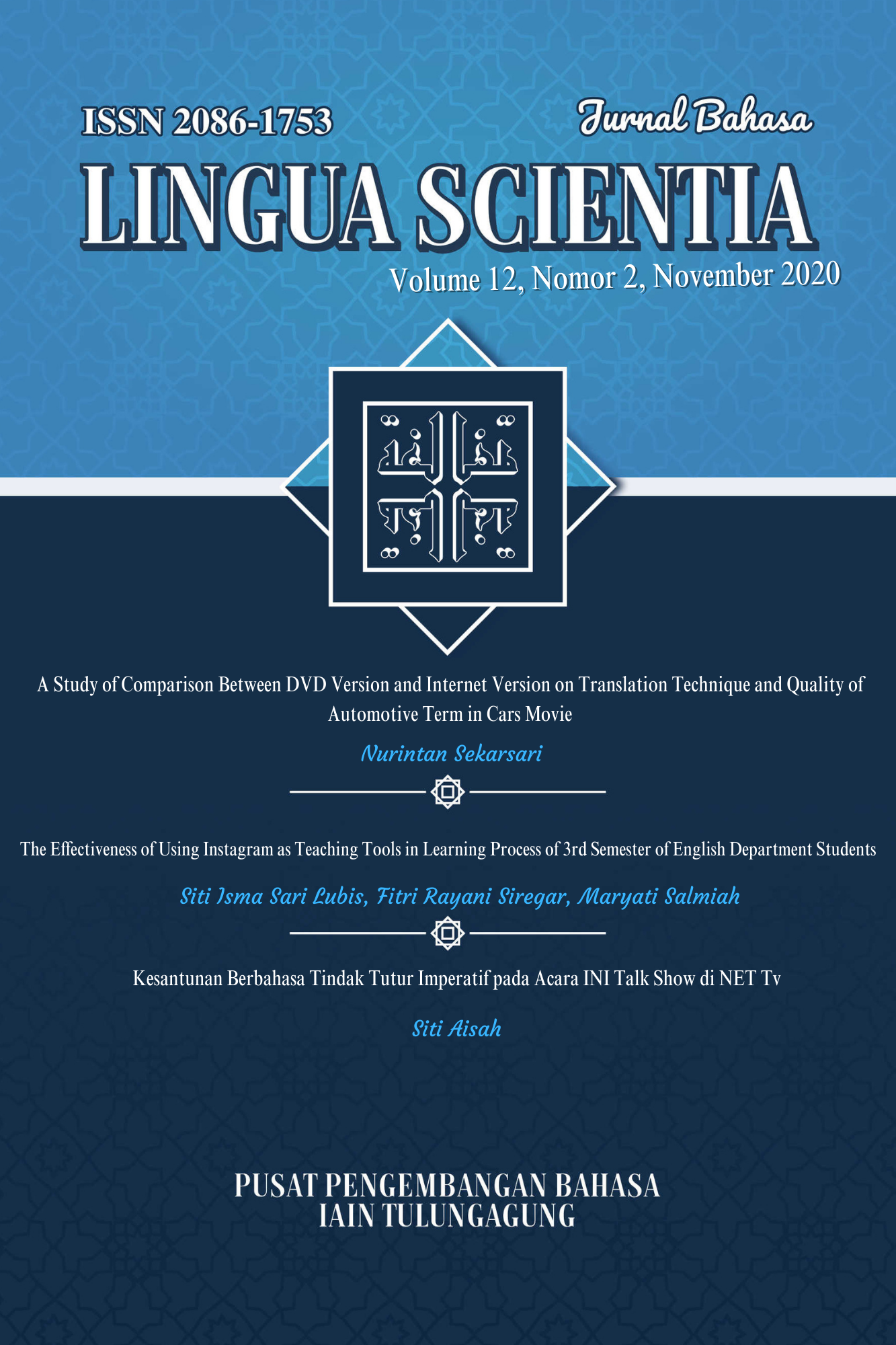SUMMATIVE ASSESSMENT OF TENTH-GRADE ENGLISH TEACHERS FROM HOTS PERSPECTIVE
Abstract
This research intends to analyze how Higher Order Thinking Skills are reflected in summative assessment used by Tenth-grade English teachers from HOTS perspective based on Revised Bloom's Taxonomy. This research used qualitative research with a content analysis method to know the extent of HOTS items that are reflected in the teacher-made test. To collect the data, document analysis and interviews were applied. From the data that have been obtained, it was found out that the HOTS-based item used by the teachers was still relatively low. There were only 6 out of 125 items that can be categorized as HOTS-based items with a percentage of 4.8%. HOTS-based items that have been found were also limited to the Analyze category (C4). In the C4 level, three indicators or sub-skills were included such as differentiating, organizing, and attributing. Among six HOTS-based items, 2 items were categorized as differentiating indicators, 1 item belonged to the organizing indicator, and 3 items were attributing indicator. Furthermore, the result of the interview indicated that the teachers need to learn more about HOTS to get a better understanding in constructing HOTS-based items.
Downloads
References
Abosalem, Y. (2016). Assessment techniques and students’ higher-order thinking skills. International Journal of Secondary Education, 4(1), 1. https://doi.org/10.11648/j.ijsedu.20160401.11
Ahmad, K. (2018). The implementation of teaching LOTS and HOTS in English teaching-learning process in senior high school. RETAIN, 6(1), 121–128.
Arifin, M. A. (2017). Analysis of the Indonesian high school curriculum focusing upon the English program. IDEAS: Journal on English Language Teaching and Learning, Linguistics and Literature, 134–145.
Bengtsson, M. (2016). How to plan and perform a qualitative study using content analysis. NursingPlus Open, 2, 8–14. https://doi.org/10.1016/j.npls.2016.01.001
Brown, H. D. (2003). Language assessment principles and classroom practices. California: Longman University Press.
Chinedu, C. C., Kamin, Y., & Olabiya, O. S. (2015). Strategies for improving higher order thinking skills in teaching and learning of design and technology education. Journal of Technical Education and Training, 7(2), 35–43.
Darwazeh, A. N., & Branch, R. M. (2015). A Revision to the Revised Bloom ’ s Taxonomy. Thannual, (1990), 220–225.
Driana, E., & Ernawati. (2019). Teachers’ understanding and practices in assessing higher order thinking skills at primary schools. Acitya: Journal of Teaching & Education, 1(2), 110–115.
Houston, D., & Thompson, J. N. (2017). Blending formative and summative assessment in a Capstone Subject : ‘ It ’ s not your tools , it’s how you use them. Journal of University Teaching & Learning Practice, 14(3). Retrieved from http://ro.uow.edu.au/jutlp/vol14/iss3/2
Kemendikbud. (2017). Modul penyusunan soal higher order thinking skill (HOTS). Jakarta.
Kibble, J. D. (2017). Best practices in summative assessment. Advances in Physiology Education, 41(1), 110–119. https://doi.org/10.1152/advan.00116.2016
Looney, J. W. (2011). Integrating formative and summative assessment : Progress toward a seamless system? OECD Education Working Papers, (58). Retrieved from http://ro.uow.edu.au/jutlp/vol14/iss3/2
Marhaeni, A. A. I. N., Dantes, N., & Paramartha, A. A. G. Y. (2018). Teacher assessment literacy : Discrepancies in authentic assessment practice in EFL context. International Conference on Educational Assessmnet and Policy, 2, 18–21.
Miri, B., David, B. C., & Uri, Z. (2007). Purposely teaching for the promotion of higher-order thinking skills: A case of critical thinking. Research in Science Education, 37(4), 353–369. https://doi.org/10.1007/s11165-006-9029-2
Mohamed, R., & Lebar, O. (2017). Authentic assessment in assessing higher order thinking skills. International Journal of Academic Research in Business and Social Sciences, 7(2), 466–476. https://doi.org/10.6007/IJARBSS/v7-i2/2021
Qu, W., & Zhang, C. (2013). The analysis of summative assessment and formative assessment and their roles in college English assessment system. Journal of Language Teaching and Research, 4(2), 335–339. https://doi.org/10.4304/jltr.4.2.335-339
Razali, K., & Jannah, M. (2015). The comparison between national final examination test items and English teacher made-test items of 2010 and 2011. Al-Ta Lim Journal, 22(1), 10–22.
Retnawati, H., Djidu, H., Kartianom, Apino, E., & Anazifa, R. D. (2018). Teachers’ knowledge about higher-order thinking skills and its learning strategy. Problem of Education in the 21st Century, 76(2), 215–230. Retrieved from http://oaji.net/articles/2017/457-1524597598.pdf
Seman, C. S., Yusoff, W. M. W., & Embong, R. (2017). Teachers challenges in teaching and learning for higher order thinking skills ( HOTS ) in primary school. International Journal of Asian Social Science, 7(7), 534–545. https://doi.org/10.18488/journal.1.2017.77.534.545
Surgenor, P. (2010). Teaching toolkit: Summative & formative assessment. Dublin, İrlanda: University College Dublin.
Tanujaya, B., Mumu, J., & Margono, G. (2017). The relationship between higher order thinking skills and academic performance of student in Mathematics instruction. International Education Studies, 10(11), 78. https://doi.org/10.5539/ies.v10n11p78
Copyright (c) 2020 Anggita Prasistha Utami

This work is licensed under a Creative Commons Attribution-NonCommercial 4.0 International License.
Before going to review process, all manuscripts will be checked that they are free from plagiarism practice using "Turnitin" software. If there is an indication of plagiarism, the manuscript will instantly be rejected.


